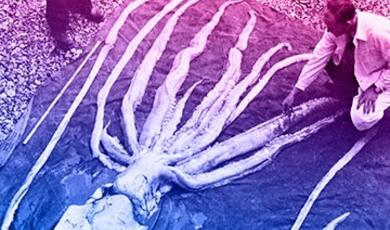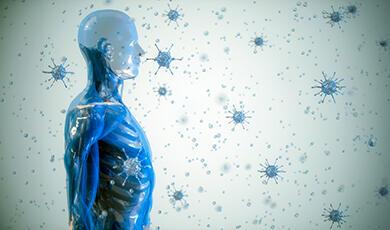How Microbes Manipulate Life
Share
- Details
- Text
- Audio
- Downloads
- Extra Reading
Every animal on the planet carries with it an astonishingly diverse microbial zoo – millions of invisible organisms that thrive on the skin and in the gut. They play an important role in health and disease and may also shape human emotions and behaviour. Viruses may stimulate aggression, parasites can trigger suicide and bacteria can block fear responses. The evidence for our interaction with microbes may even make us want to re-evaluate the concept of free-will.
Download Text
How Microbes Manipulate Life
Professor Robin May
22nd March 2023
Free will is a fundamental feature of human society. It underpins core concepts such as criminal responsibility, and consequently those who appear to act without free will are deemed to have serious mental health issues.
And yet the natural world is full of examples of organisms acting not under their own free will but under the ‘direction’ of invisible forces that drive them to perform acts of self-harm or even suicide. How do they do this, what does it mean for our understanding of free will, and how worried should we, as humans, be? Join us for this lecture as we enter the dark and disturbing world of Microbial Manipulators…
Here Today, New Host Tomorrow
Earlier in this lecture series we encountered a cast of diverse microbes that make their living at the expense of other organisms. These pathogens and parasites come in all shapes and sizes; from miniscule viruses and bacteria to multicellular fungi or parasitic worms. But what they have in common is the need for a host; another organism that they live in or on and from which they derive benefit at the host’s expense, for instance, by ‘stealing’ nutrients or degrading host tissues.
The evolutionary success of a pathogen is directly linked to its ability to colonise new hosts – if a pathogen has not spread some of its progeny to a new host before the current one dies, then its evolutionary legacy dies with its host. We became all-too-familiar with this concept – known in mathematical terms as ‘R0’ – during the SARS-CoV-2 pandemic. When the R0 value was above 1, then, on average, each infected person transmitted the virus to more than one other person and the pandemic spread.
Natural selection therefore works strongly on pathogens to optimise their ability to transmit between suitable hosts, which is one of the reasons why vaccine escape strains of viruses arise. We have previously seen the extraordinary power of natural selection to drive biological microbial innovation, leading to the evolution of powerful toxins or extraordinary physiological capabilities. So perhaps it should not surprise us that natural selection has also led many microbes to evolve remarkable mechanisms to manipulate their host species into unwittingly optimising the transmission of their invisible passengers.
Riding The Crest of a Sneeze
For many pathogens, behavioural manipulation of their host is not a subtle process. Respiratory viruses, for instance, are typically transmitted either as aerosols or as droplets deposited onto surfaces such as door handles. It is therefore no surprise that most respiratory infections trigger behaviours such as coughing or sneezing that vastly increase both the quantity and the range of expelled virus particles. In fact, a powerful sneeze can propel droplets at speeds close to 100mph, with a range of up to 9m – something worth thinking about next time someone sneezes at the other end of a bus from you. This is often coupled with very high infectious loads – a single cough from a Covid-19 patient may contain 100 000 viral particles. It therefore stands to reason that a respiratory pathogen that does not induce coughing will be very rapidly outcompeted by one that does. Of course, there is also an evolutionary trade-off here, though, since a virus that induces profound coughing is also likely to lead its victim to self-isolate or seek medical treatment, which will dramatically reduce the pathogen’s opportunity for transmission. So often what we see in the real world is pathogens evolving towards a ‘Goldilocks’ position, in which they induce strong enough symptoms to maximise transmission without turning their host into a bed-ridden invalid.
The Way to a New Host Is Through Its Stomach…
A similar situation arises with the numerous pathogens that make their living the gastrointestinal tract. Pathogens such as Campylobacter, E. coli, cholera and many others are primarily transmitted through the fecal-oral route; in other words, bacteria that are transmitted from the faeces of one person to the food of another. For those of us living in the relative luxury of a high-income developed country, the major contributor to this route is poor hygiene – inefficient handwashing after going to the toilet, or a failure to wash crops that have been exposed to animal faeces, for instance. However, over most of evolutionary time we have not had access to clean water or disinfectants and so the ability of gastrointestinal pathogen to spread was closely linked to its ability to host defecation. Consequently, it is unsurprising that many of these pathogens produce toxins that are specifically designed to trigger frequent, uncontrolled and often ‘explosive’ diarrhoea, significantly increasing the likelihood of transmission to new hosts. Some organisms, though, go much further than this…
Many pathogens are dependent on not one, but two or more host species. An obvious example is malaria, which is strictly dependent on both mosquitoes and mammals for its life cycle. Typically, one of these host species supports sexual reproduction of the pathogen and is called the DEFINITIVE host (in the case of malaria, this is the mosquito), whilst the other supports growth (and sometimes asexual replication) of the immature parasite and is called the INTERMEDIATE host (the human, in this case). For such pathogens, ensuring transmission from the definitive host species to the intermediate and vice versa is critical, and many of them have evolved positively dastardly ways to achieve this.
For instance, the wonderfully named ‘spiny headed worms’ (Acanthocephala) are a group of parasites that typically infect invertebrates (the intermediate host) and birds (the definitive host). Transmission occurs when the latter consumes the former and so it is in the parasite’s interests to ensure that the invertebrate within which it resides is likely to get eaten by a passing bird…and some of them do so with style. Woodlice infected with Plagiorhynchus cylindraceus develop an unhealthy interest in walking in open areas, instead of beneath leaves, and so become eaten by starlings. Aquatic crustaceans infected with Polymorphus species start clinging to leaves near the water surface and so get eaten by ducks. And cockroaches infected with Moniliformis moniliformis lose their escape response and therefore end up as lunch for rodents. In all three cases, by manipulating the behaviour of the intermediate host, these parasites ensure a much higher probability of transmission to their definitive host.
“And So, After All, We Are but Puppets…”
It is relatively easy to imagine pathogens manipulating the behaviour of an insect or crustacean – after all, these ‘simple’ animals often appear like robots that are driven by straightforward desires about food or reproduction. But surely the extraordinary complexity of the human brain, together with all of the intricate cultural and behavioural nuances of our day to day life, mean that no microscopic organism could ever play puppet-master with us, could it?
In fact, we have known for hundreds of years that they can. One of the most dramatic and dreadful examples is the rabies virus. Typically contracted from a dog bite, once the infection is established it is both irreversibly deadly. During progressive rabies, affected patients display a range of bizarre behaviours; profound fear of water, aggression, confusion and hallucinations. These are the signs of the virus moving steadily through the human central nervous system and altering its victim’s behaviour as it does so. The mechanism by which it achieves this is still an enigma, although recent work has suggested that part of a protein on the viral surface is able to inhibit the nicotinic acetylcholine receptor, a critical neuroreceptor in the brain.
The behavioural impact of rabies is impossible to overlook, but not all pathogens are as overt in their effects. One that has been the focus of intense investigation in recent decades is the parasite Toxoplasma gondii. This distant relative of malaria is another example of an organism with a multi-host lifecycle. Its definitive host is always feline (often a pet cat), but its intermediate host can be almost any warm-blooded animal, although typically it is a small mammal, such as a rat or mouse.
Most small rodents tend to be rather good at avoiding cats, so one might think that host-to-host transmission is a challenge for Toxoplasma. However, the parasite has a sneaky trick up its sleeve – once established, it alters the behaviour of its rodent hosts such that they lose their fear of cats and often seek out areas with strong feline odours such as cat urine. Unsurprisingly, this reckless behaviour leads Toxoplasma-infected animals to fall prey to felines at a high frequency, ensuring successful transmission of the parasite.
All of this might be purely of academic interest, were it not for the fact that Toxoplasma often ends up in human hosts too, either through consuming undercooked meat from infected animals (such as pigs) or from poor hygiene when handling cat litter or other infectious sources. Humans are a dead-end host for the parasite (not many of us end up being consumed by felines, happily!), but the parasite doesn’t ‘know’ that, so in humans it behaves exactly as it does in a rodent. It encysts in muscle or neural tissue and attempts to manipulate its host’s behaviour. Historically, we assumed that these manipulations were entirely unsuccessful, but more recent epidemiological data suggest that the parasite might be more successful than we realised. Toxoplasma-infected individuals show a higher probability of schizophrenia, or being involved in road-traffic accidents, especially those that involve aggressive behaviour. More intriguingly, infection is associated with much more subtle displays of ‘risky’ behaviour, such as higher probability of starting your own business, but also of abandoning the venture later. With around one in three of us worldwide already harbouring this tiny parasite in our brains, it’s possible that Toxoplasma may have a far more profound impact on human society than we have previously realised.
Feed Your Mind…
Our understanding of the ways in which microbes influence host behaviours is in its infancy and in most cases we have no idea at all about the molecular mechanisms by which manipulation may be achieved. But the more we look, the more common we find such manipulation to be. In which case, it seems reasonable to assume that any large and diverse microbial population may have some species within it that engage in host manipulation. So what does that mean for one of the largest and most diverse microbial populations that we know of – the gut microbiome?
At first glance, it seems unfeasible that microbes living in your gut could affect the activity of the human brain. However, a deeper reflection reveals the flaw in this argument – after all, your gut has a direct line to your brain in order to report on hunger and satiety, and the reverse route is also well-established, as anyone who has experienced stress-induced diarrhoea can attest to. So might the activity of your gut microbes have an impact on your behaviour?
Experimental evidence in other animals suggests the answer is a firm “yes”. There is a significant difference in the microbiome composition between laboratory mice that are either dominant or subordinate in social interactions. Inoculating a ‘germ-free’ mouse (one that has been raised under sterile conditions and therefore has no microbiota of its own) with faeces from a subordinate animal leads it to start to display submissive behaviours. Similarly, transferring microbes from the gut of a rat that is displaying depression-like behaviours can induce similar behaviour in an animal that was previously normal – although interestingly, only if the recipient rat was also stressed.
So what about the human microbiome? Well, just as with the case of Toxoplasma, large scale epidemiological investigations are starting to reveal the startling impact of the gut microbiome on many behaviours that we think of as fundamentally ‘human’. Different compositions of the myriad species that make up the human microbiome have been associated with several behavioural traits such as autism, schizophrenia and depression. Likewise, controlled trials in which volunteers consume specific foods that are known to alter the microbiome, such as fermented dairy products, lead to demonstrable changes in brain activity. And most recently, a study of over 600 volunteers worldwide showed striking correlations between the abundance of certain microbes in their faeces and the sociability or neuroticism of the donor. All of which might begin to suggest that ‘acting on gut instinct’ might be a much more accurate description than we currently imagine…
© Professor May 2023
Part of:
This event was on Wed, 22 Mar 2023
Support Gresham
Gresham College has offered an outstanding education to the public free of charge for over 400 years. Today, Gresham College plays an important role in fostering a love of learning and a greater understanding of ourselves and the world around us. Your donation will help to widen our reach and to broaden our audience, allowing more people to benefit from a high-quality education from some of the brightest minds.


 Login
Login







